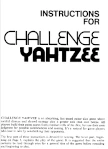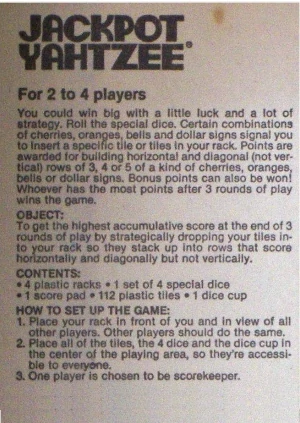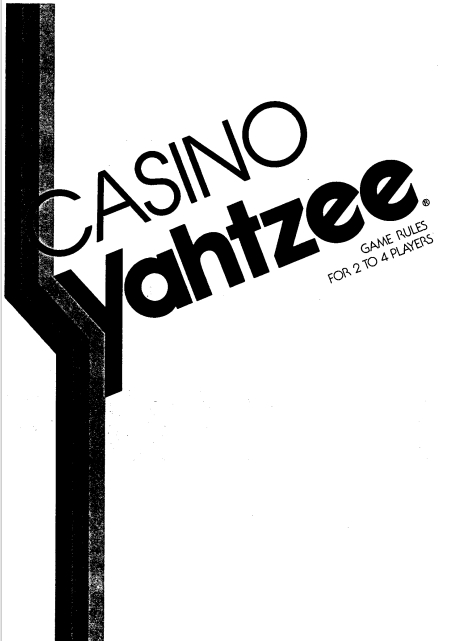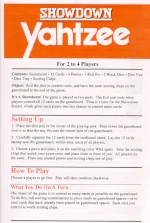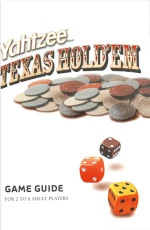Yahtzee Variations
There are a ton of different ways to play Yahtzee. Yahtzee Turbo, Yahtzee Jr., and Yahtzee Texas Hold‘em – they are just the tip of the iceberg when it comes to the diversity of Yahtzee gaming. These officially licensed variant games use unique rules, equipment, scoring and gameplay elements to take the familiar game to new and wonderful places. Learn about the original six Yahtzee variations: Triple Yahtzee, Challenge Yahtzee, Word Yahtzee, Jackpot Yahtzee, Casino Yahtzee, and Showdown Yahtzee.
Different Yahtzee Versions
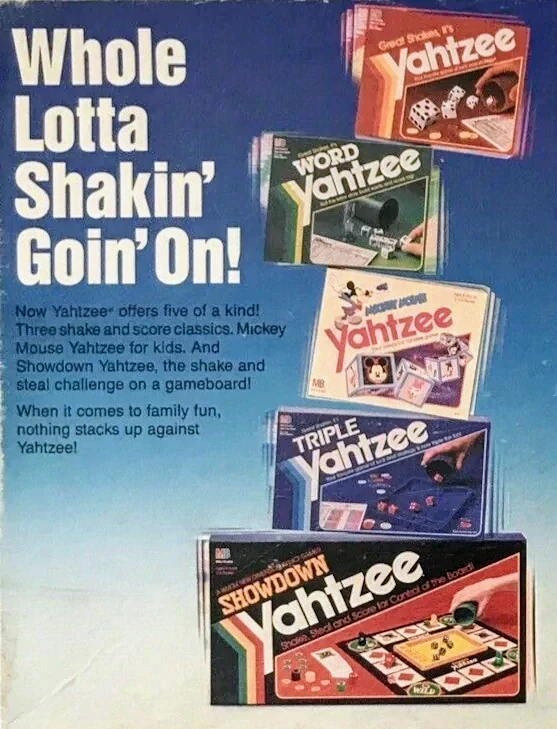
The original source of the game now known as Yahtzee is hard to pin down with certainty, but its various origin stories are fantastic. It was either invented by a wealthy couple on a worldwide yacht trip, dreamt-up by the board game executive who created the game Bingo, or has been played for thousands of years in central Asia. But despite the murkiness surrounding the mother game, it has spawned an array of derivatives whose histories can be clearly traced.
Standard Yahtzee was first mass-produced in 1956 and quickly went on to become the best-selling dice game in history. As a result of this commercial success, the game’s modern corporate overlords sought ways to expand Yahtzee’s reach even further. Rapid advancements in computer technology allowed the game to move into the digital era where it proliferated on gaming consoles, personal computers, and smartphones. The ability to play Yahtzee online is one of the greatest successes stories of a tabletop game making the digital jump. But even before the electronic revolution made it possible to put Yahtzee in everyone’s pocket, the game had been branching out in new ways.
The easiest way to cash-in on widespread brand recognition was to create entirely new tabletop games within the growing Yahtzee family. Different Yahtzee games were key to future growth. Each of the Yahtzee variations would put a new spin on the old favorite by introducing an entirely new set of rules and/or gameplay. Sometimes elements from other popular games would be grafted onto the the original Yahtzee concept to form something different, if not entirely original. Considering that standard Yahtzee incorporates elements of Poker, it shouldn’t be surprising to see its offspring adopt a similar strategy.
Prior to the official release of the very first derivative game, Triple Yahtzee in 1972, deviation from standard Yahtzee rules only occurred in the unregulated underground board game scene. While none of these house rules made their way into an officially licensed Yahtzee product, many of them remain popular today. But the E.S. Lowe Company did eventually come to realize the potential of tapping into the variant rules craze and launched a covert R&D operation in the early 1960s with the goal of producing a viable Yahtzee variation game prototype. After millions of dollars of research and development, it turned out that you can just multiply your scores by three.
It turns out there are many different ways to play Yahtzee. While parent company Hasbro continues to probe the boundaries of the rule book and the Yahtzee game itself, the earliest variant games found varying levels of success in the marketplace and none of them are still in production. But sometimes the classics are hard to top. Each variant maintains a loyal throng of devoted followers and represents a precious artifact of yesterday’s Yahtzee.
Triple Yahtzee
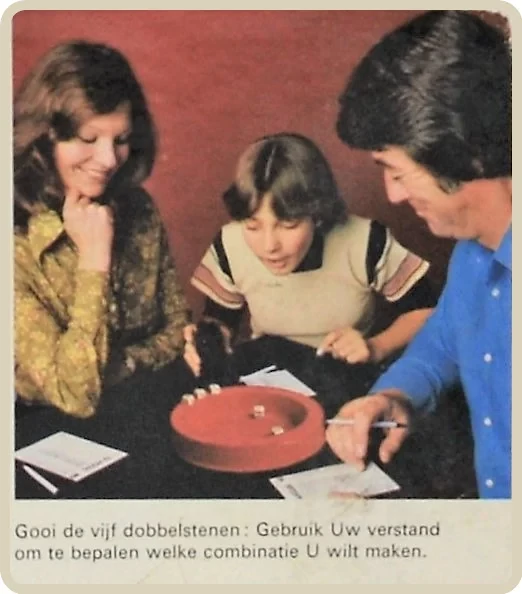
In the early days of Triple Yahtzee, this innovative spin-off quickly captured the interest of dedicated Yahtzee enthusiasts. Introduced as a fresh twist on the classic game, it provided an exciting new layer of strategy that set it apart. Players were intrigued by the concept of playing three games simultaneously, which required careful planning and tactical decision-making. The addition of scoring multipliers in the second and third columns added a compelling challenge, transforming familiar gameplay into a deeper, more engaging experience. This clever enhancement maintained the essence of the original while appealing to those looking for something more complex.
As word spread about Triple Yahtzee, it became a favorite among families and game night groups. Its unique blend of strategy and familiarity resonated with both seasoned players and newcomers alike. Despite its longer playtime, many found the game's extended duration to be part of its charm, offering more opportunities for social interaction and friendly competition. The early success of Triple Yahtzee demonstrated the potential for derivative games to breathe new life into classic favorites, solidifying its place as a beloved variant in the Yahtzee franchise. This period marked the beginning of Triple Yahtzee's enduring popularity and its role in expanding the boundaries of traditional dice games.
Challenge Yahtzee
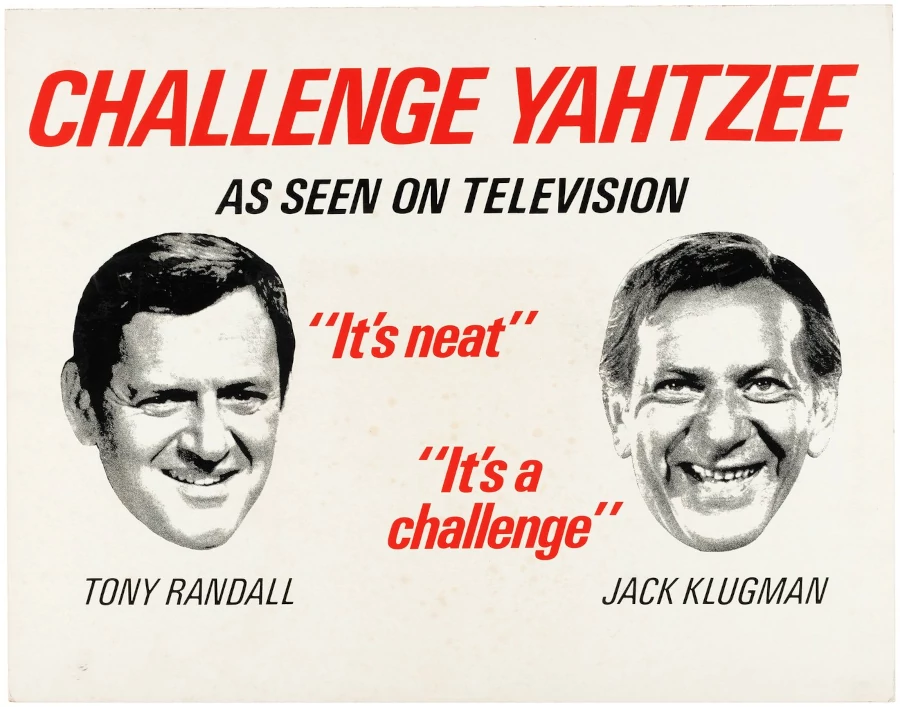
In 1974, two years after Triple Yahtzee entered the world, the next variant game was released under new corporate owner Milton Bradley: Challenge Yahtzee. The new management took an enthusiastic approach toward further variation and launched a huge marketing campaign to promote their product. Jack Klugman and Tony Randall, stars of the hit TV show, The Odd Couple, were hired for advertisements. Challenge Yahtzee is still the only Yahtzee game to have had an official celebrity endorsement.
Gameplay is identical to the standard game except that all players score their turns from the same roll. They decide individually which dice to keep and how to score the rolls but all must work from the same dice. It’s this common roll element that forces tactical decision-making to the forefront. The official rule book concludes that “Although luck plays a role, the winning player will have used the best strategy.”
Challenge Yahtzee is the closest variant to a socialized form of Yahtzee, where dice rolls are used in common amongst the working masses. It also has the effect of keeping distracted, sleepy, or drunk participants focused on the game since all players are active on every roll. The decreased downtime is a sure improvement but the 1974 family may wonder why they paid good money for a game that could be played just as easily with their original Yahtzee set. Even the scorecard is the same as the standard version. But the dice tray and rolling board are innovative, if superfluous, new additions.
Marketing Slogans:
“All players score from the same roll.”
"It's neat."
Resources:
Word Yahtzee

In 1978 Yahtzee metamorphosed into a spelling game. Original Yahtzee owner, the E.S. Lowe Company, had been producing Scribbage, a word-based dice game, since 1959. To boost sales for the flagging game, a pared-down version was fused with Yahtzee elements and rebranded as Word Yahtzee. It was a shot across the bow of the upstart spelling game Boggle, which had released to much fanfare in 1972, that Yahtzee was serious about rolling some words.
The main deviation from the standard game is Word Yahtzee’s use of letter dice. Players roll seven dice within a one minute period to form words and earn points. The face of each die features a letter, along with a subscript number to indicate the score for that letter - just as in the game Scrabble. The scorecard has a familiar Yahtzee feel with Upper and Lower Sections. To score a Yahtzee a player must be able to form a 7-letter word.
Word Yahtzee really took Yahtzee in a whole new direction. The first two variant games took care to not veer too far from the original’s tried and true gameplay elements. While Word Yahtzee did keep the dice, it removed numbers from the equation. Perhaps because of its tenuous relationship to vanilla Yahtzee, Word Yahtzee is typically one of the lowest reviewed variant games.
Marketing Slogans:
“Traditional Yahtzee game with a daring difference - build words and word combinations to outscore your opponent.”
“Roll the letter dice, build words and score big!”
Resources:
Jackpot Yahtzee
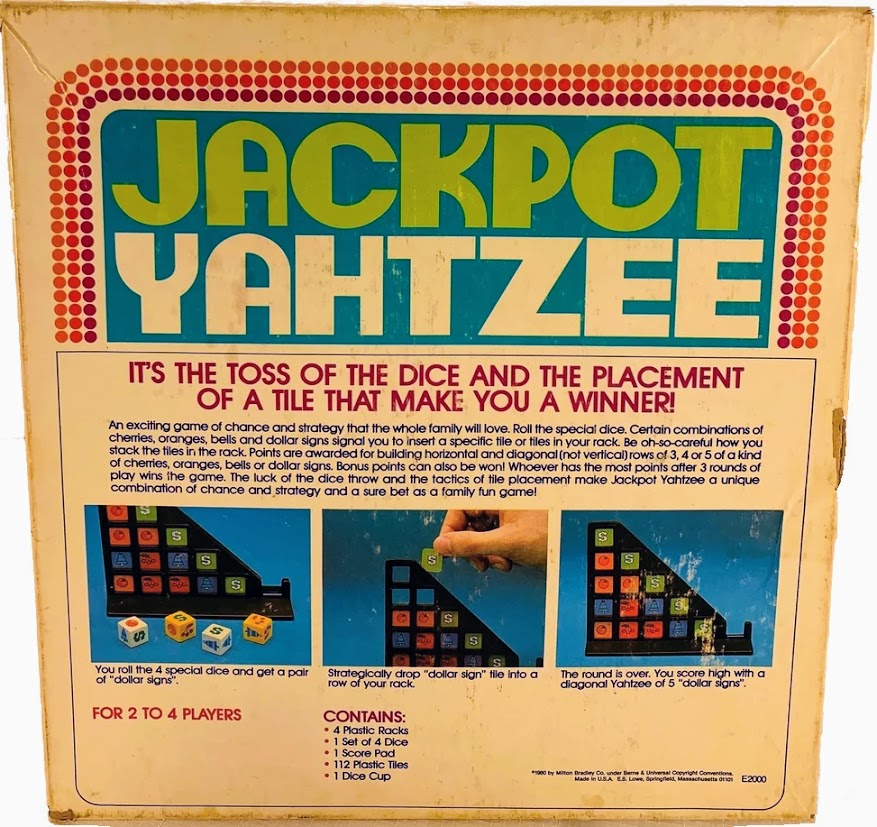
Jackpot Yahtzee is generally considered to be in the upper echelon of variant games but unfortunately it also had the shortest production run. Using Word Yahtzee as a template, it continued the trend of incorporating gameplay from other games into Yahtzee by leaning heavily into mechanics borrowed from the 1970’s hit Connect-Four. The design invoked an exciting esthetic of casino imagery, like using typical slot machine symbols - dollar signs, bells, oranges, and cherries - on the dice.
In addition to special dice, Jackpot Yahtzee features plastic racks into which tiles are dropped to score points. Gameplay involves players rolling the four special dice to earn tiles. The tiles are then tactically inserted into the 16-slot triangular scoring rack to form horizontal or diagonal rows. The effect is reminiscent of spinning winners on a slot machine.
Some players feel that the hybridisation of Yahtzee and Connect-Four feels sloppy, with the latter game’s mechanics simply tacked on. But it undeniably adds another layer of strategy to keep players thinking. Prized for its unique game equipment, innovative tactics, and overall rarity, it is considered to be a rare gem to Yahtzee connoisseurs.
Marketing Slogans:
“Win big with a little luck and a lot of strategy.”Resources:
Casino Yahtzee
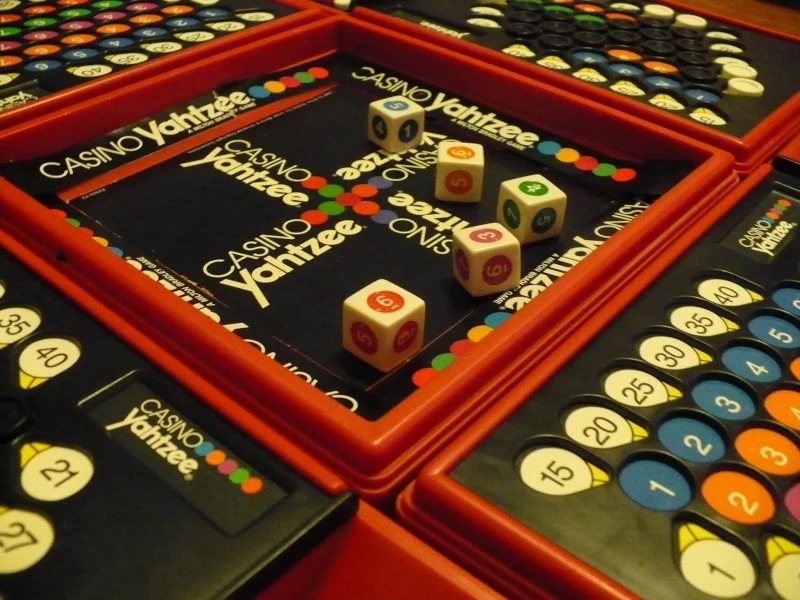
Casino Yahtzee was released in 1986, continuing the casino theme used for Jackpot Yahtzee. It is a natural motif since Yahtzee was heavily influenced by Poker, but it had already been done with the previous game. Casino Yahtzee may have been in fact a reboot of the stylistic gimmick since Jackpot Yahtzee landed with a dud.
The game itself has little to do with casino gaming and is more clearly influenced by the game Bingo. Yahtzee and Bingo were both created by E.S. Lowe so it’s an unintentional but fitting tribute that Casino Yahtzee was released in the year of his death. Each player rolls the dice and then marks the corresponding numbers on a 51-space game board. Points are scored when the final space in a row, column, or diagonal is marked or “closed.”
Casino Yahtzee expanded the limits of Yahtzee by introducing the concept of an official scorekeeper, who keeps track of scores and calculates the totals for all players. It also features a popular scoring combination with a great name, the Rainbow Bonus, that doubles the points. Although it strays a bit from Yahtzee’s core game mechanics, the addition of Bingo elements to Casino Yahtzee makes for an exciting game.
Marketing Slogans:
“The high-rolling dice game.”Resources:
Showdown Yahtzee
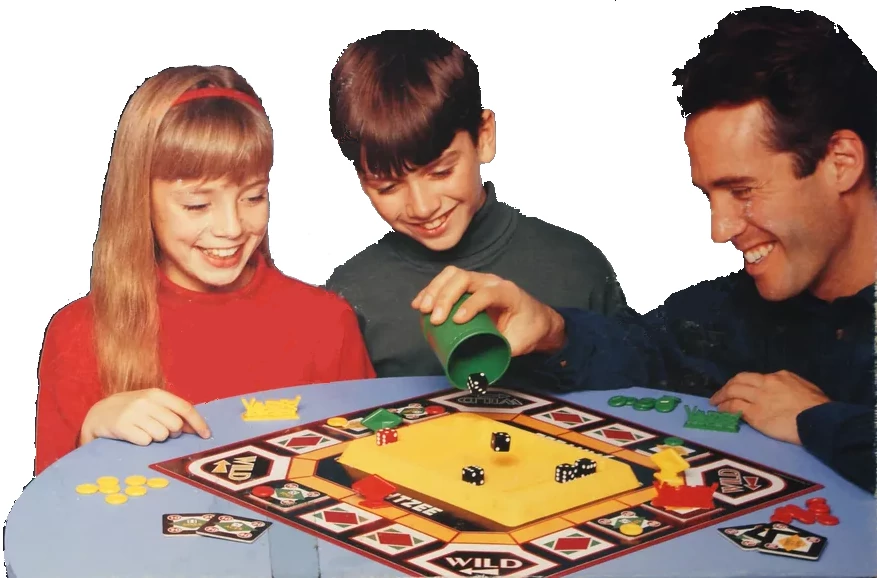
The age-old question of whether or not Yahtzee classifies as a board game was finally settled with the release of Showdown Yahtzee in 1991. There is no way you can miss the oversized board featured in this Yahtzee variant game. Under the influence of Monopoly-esque game mechanics, players are able to move their game piece around the board while fighting to gain control of open spaces.
When a player lands on an open space, they try to complete a standard Yahtzee scoring combination. If successful, they place the card for that combination on the space along with a certain number of chips to mark their ownership. If another player lands on that space later, they have to match or beat the roll to steal ownership of the board space. When a player rolls a Yahtzee, it’s treated like a wild card where they can ignore the space they're on and claim ownership of any space on the board. The game climaxes with Showdown Mode, a form of sudden death where players can steal cards from one another. After all players have played a round in Showdown Mode, the game ends and the player with the most chips on the board is the winner.
Yahtzee variations work best when they add an intriguing new layer of strategic thinking to the game. But some Showdown Yahtzee players complain that the addition of a game board simply adds another layer of luck. The board does indeed often limit decision making ability when a player is forced to roll a certain scoring combination. And too much emphasis is placed on the Showdown Mode, which really determines the winner, often leaving the opening rounds feeling a bit meaningless. Overall, Showdown Yahtzee features the same great game mechanics as Monopoly with none of the capitalistic domination.
Note: Confusingly, Showdown Yahtzee was released under different names in different regional markets. To make matters worse, a couple of these names were identical to previous Yahtzee titles. For example, it was known as Casino Yahtzee in the Netherlands and Challenge Yahtzee in the UK.
Marketing Slogans:
“Shake, steal & score for control of the board.”Resources:
Yahtzee Deluxe Poker

The year 1994 saw the release of Last Chance, which was renamed Yahtzee Deluxe Poker in 2005. It is a poker-inspired Yahtzee variation that includes contract bidding and side betting. The game consists of 36 cards, each bearing a combination and its corresponding value. Seven cards are placed in the tray and are used in the game. Players bid for the right to roll the dice and achieve the combination on the card. If the rolling player achieves the combination, they win the value of the card, the card itself, and all bets against them. If the rolling player fails, they lose the bid money to the bank. The game continues until the combination on the card is achieved by any player.
The game also features a ‘Joker’ element, which differs from the standard Yahtzee Joker rule. In Yahtzee Deluxe Poker, a card may have Joker spaces that can stand for any number. If there is more than one Joker, the player must decide which value each Joker will represent. Players can also go for the "All In" or namesake "Last Chance" option, especially if they are almost out of chips and have not won a card. This option allows players to bet all of their remaining chips, but they must win at least one card to stay in the game. The player with the most chips after the seven chosen cards are played and won is declared the winner.
Marketing Slogans:
“The risk and roll game of bidding and betting!”
"It's a daring dice game and a pulse pounding poker game - all in one!"Resources:
Yahtzee Texas Hold'em
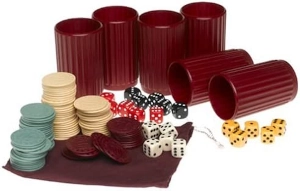
Yahtzee Texas Hold'em combines elements of two classic games: standard Yahtzee and Texas Hold'em poker. In an effort to add a sense of familiarity for the gaming public, Yahtzee was originally designed to incorporate aspects of Poker. Scoring combinations like Full House, Three of a Kind, and the Straights are borrowed from the popular card game. Yahtzee Texas Hold'em is a logical continuation of this process to further integrate popular gameplay features into yet another Yahtzee variant game.
In the game, playing cards have been replaced by 20 Yahtzee dice in four “suits” – red, black, yellow, and white. Each player picks two dice from the bag and rolls them under their own personal dice shaker. These dice remain hidden under the rolling cup. Then five "community" dice are randomly selected and rolled. Players must then make the best five-dice "hand" out of the seven total dice and place bets based upon the strength of their hands. Once the final bets are made, the players' dice are revealed and the winner is the player with the highest total. Yahtzee Texas Hold'em introduces new scoring combinations to Yahtzee such as Two Pair, Flush, Straight Flush, and Yahtzee Flush.
Released in 2004, Yahtzee Texas Hold'em capitalized on the growing popularity of the Texas hold-em poker variation. Although the card game had been around since the early 20th century it experienced a surge at the dawn of the new millennium, thanks to massive exposure on televised poker tournaments such as the World Series of Poker and World Poker Tour. It replaced seven-card stud as the most common poker game in casinos during this period. Like some other more recent variants of Yahtzee, Yahtzee Texas Hold'em failed to gain much traction in the board game market as players seemed to prefer its component parts of standard Yahtzee and Texas hold’em Poker instead of the hybridized creation.
Marketing Slogans:
“Go-For-Broke Yahtzee is here!”Resources:
Why Stray from Classic Yahtzee?
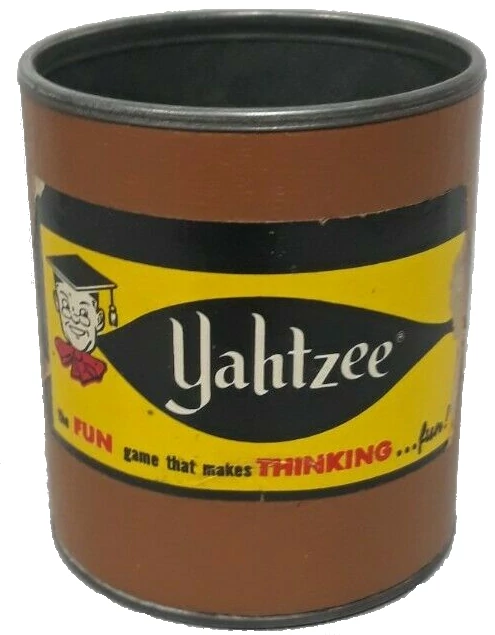
The beauty of Yahtzee lies in its simplicity and versatility. With just a set of dice and a scorecard, players can enjoy countless hours of fun and strategic gameplay. The basic rules are easy to learn, but the game also allows for a great deal of complexity and strategic depth.
This simplicity also makes Yahtzee an ideal candidate for variation games. Because the core gameplay is so well-defined, it's easy to introduce new rules or mechanics without completely changing the essence of the game. This means that players can experiment with different variations and find the one that best suits their preferences or play style.
When it comes to Yahtzee, the possibilities are endless. Over the years, players have come up with countless ways to put their own spin on the standard Yahtzee game. Some variations introduce new scoring categories or change the way dice are rolled, while others add entirely new gameplay elements to create a fresh and exciting experience. The beauty of Yahtzee is its adaptability. Whether you prefer to stick to the standard rules or try out a new variation, there's no shortage of ways to play and enjoy this beloved game.
- Gameplay variations: Yahtzee can be played with different sets of rules and different scoring systems, which can change the way the game is played and make it more challenging or easier.
- Theme variations: Yahtzee can also be played with different themes, such as a sports theme or a holiday theme, which can make the game more engaging and enjoyable for players.
- Multiplayer variations: Yahtzee can be played with different numbers of players, from one to six or more, which can change the dynamics of the game and make it more competitive or cooperative.
- Technology variations: Yahtzee can be played on different platforms such as board games, mobile apps, and online. Each platform can offer different features and game modes that can enhance the gaming experience.
- Personal preferences: Different people may have different preferences for how they like to play Yahtzee, and different variations can cater to those preferences.
Overall, the different variations of Yahtzee game are created to make the game more engaging, challenging, and fun for players of all ages and abilities, and to cater to different preferences and gaming styles. In short, Yahtzee is a game that allows players complete freedom to explore their dice curiosities in whichever way they see fit!



